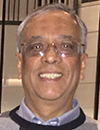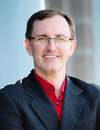10:15 AM
Welcome and Opening Remarks
Session Chair:
 |
| |
| |
Santanu Basu
Quantum Technologies
Corning Incorporated (United States) |
|
|
Santanu studied Mathematics and Applied Physics at Stanford. He worked at IBM Research, MIT, Northrop, Boeing and Corning on exciting projects in lasers, optoelectronics, space and defense. He invented a high-power laser platform, rotary disk lasers and founded Sparkle Optics. Currently he manages external collaborations in quantum projects at Corning.
10:30 AM
Silicon Photonic Quantum Computing
 |
| |
| |
Pete Shadbolt
Chief Scientific Officer
PsiQuantum (United States) |
|
|
It is increasingly accepted that all commercially useful quantum computing applications require error-correction and therefore at least 1 million physical qubits. The manufacturing capability and expertise of the semiconductor industry are needed to deliver a commercially useful quantum computer on any reasonable time or money scale. In this talk, we will show how unique technology in the areas of silicon photonics and quantum system architecture enable the path to manufacturability and scalability of a fault-tolerant, general-purpose 1-milliion qubit quantum computer.
Pete Shadbolt is co-founder and Chief Scientific Officer of PsiQuantum. Pete earned his PhD in experimental photonic quantum computing from the University of Bristol and was a postdoc at Imperial College, researching the theory of photonic quantum computing. During his time at Bristol, Pete demonstrated the first-ever Variational Quantum Eigensolver and created the world’s first programmable quantum photonic chip, now part of a permanent exhibition at the London Science Museum.
10:50 AM
Optically Trapped Atomic Qubits
 |
| |
| |
Jonathan King
Co-Founder and Chief Scientist
Atom Computing (United States) |
|
|
Ultracold neutral atoms have emerged as a leading platform for scalable quantum simulation, but can they be similarly used for gate-based quantum computation? In this talk, I will present an overview of major accomplishments in academia that have spurred multiple different startups to enter the quantum computing race, focusing on the use of neutral atoms as a scalable qubit platform. With these proof of principle demonstrations in mind, I will describe Atom Computing's first prototype system and recently announced use of a unique qubit to achieve bare coherence times in excess of 20 seconds. Utilizing qubit states that are broadly insensitive to the environment they are trapped in, this system is quickly becoming a testbed for how to build programmatic control into neutral atom systems that rivals other leading quantum computing platforms.
Jonathan King is Co-Founder and Chief Scientist at Atom Computing. Jonathan has over a decade of experience as a researcher in quantum technologies. Prior to joining Atom Computing, he was a postdoctoral researcher at the University of California, Berkeley where he worked on a variety of experimental and theoretical projects in the realm of nuclear magnetic resonance spectroscopy.
11:10 AM
Microfabricated Ion Traps for Quantum Information
 |
| |
| |
Melissa Revelle
Senior Member of Technical Staff
Sandia National Laboratories (United States) |
|
|
Surface electrode ion traps offer a clear advantage in quantum information over traditional 4-rod traps by enabling the precise control necessary for manipulating a long chain of ions. At Sandia, we use CMOS compatible fabrication techniques to make these devices more complex and repeatable; a likely necessity when building quantum systems with hundreds or thousands of ions. These techniques grant us access to unique integration capabilities, through which we aim to continuously improve the state-of-the-art of surface ion traps. I will share some examples of our capabilities and recent work on our Phoenix and Peregrine traps which aim to improve the reliability and performance of previous designs.
Sandia National Labs is managed and operated by NTESS LLC, a subsidiary of Honeywell International, Inc., for the U.S. DOE's NNSA under contract DE-NA0003525. The views expressed in the article do not necessarily represent the views of the DOE or the U.S. Government.
Melissa Revelle is currently staff at Sandia National Laboratories studying trapped ion quantum information where she focuses on improving ion trap technology and developing the open testbed system, QSCOUT. Melissa earned her PhD in atomic physics from Rice University in Houston, for investigating the dimensional crossover in ultracold Fermi gases before becoming a trapped ion postdoc at Sandia.
11:30 AM
Panel Discussion on the Role of Photonics in Quantum Computing
Moderator:
Santanu Basu, Corning Incorporated (United States)
Panelists:
Jonathan King, Atom Computing (United States)
Melissa Revelle, Sandia National Laboratories (United States)
Pete Shadbolt, PsiQuantum (United States)
Mark Tolbert, TOPTICA Photonics Inc. (United States)
Additional Panelist:

|
| |
| |
Mark Tolbert
President
TOPTICA Photonics Inc. (United States) |
|
|




